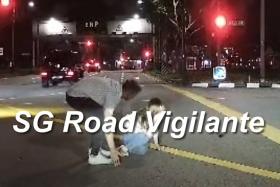‘Wearing your seat belt gives me a chance to save your life’
Belting up will not completely protect you from injury in a traffic accident, but you will be much less likely to suffer life-threatening injuries, a trauma surgeon said.
Adjunct Assistant Professor Teo Li-Tserng, director of the Tan Tock Seng Hospital (TTSH) Trauma Centre, said the chances of an unbelted patient getting to a hospital alive after a bad crash is close to zero.
Prof Teo, who is also regional director of the Central Region Trauma Services under the National Healthcare Group, said many of these passengers are severely hurt by the time they reach the hospital, and some die on the spot.
He added: “Those who wear a seat belt may still get injured, but their injuries are usually not as immediately life-threatening. This gives them time to be transported to a hospital where they can be treated.”
TTSH statistics paint a sobering picture.
Prof Teo said that since 2001, the percentage of unbelted accident patients at the hospital has been rising and consistently surpassed patients who were belted up.
The hospital admitted 12 rear seat passengers with moderate to severe injuries each year in 2022 and 2023.
Of these, five were not wearing seat belts in 2022 and the figure rose to nine in 2023.
Traffic Police statistics show the number of violations for failing to wear a seat belt, or wearing it improperly, have fallen recently.
Such violations went down from 5,863 in 2021, to 4,763 in 2022 and 3,559 in 2023.
But figures from the National University Centre for Trauma showed the number of traffic accident patients in the western region who were not wearing seat belts and got severely injured rose from 20 in 2022 to 25 in 2023.
The centre at the National University Hospital was launched in July and focuses on improving safety and trauma care for children, older adults and migrant workers.
Prof Teo said more rear seat passenger patients wore seat belts in 2009 – 60 per cent compared with 40 per cent who did not – after a nationwide reminder of Singapore’s seat belt laws.
“This was transient. From 2011, the number of rear seat passenger patients who wore seat belts dropped precipitously to less than 20 per cent,” he added.
Prof Teo said he often sees unbelted patients suffer head, spinal and chest injuries. In more severe cases, they also suffer liver and spleen damage.
“Unbelted patients tend to get flung around the vehicle. If they have severe brain and spinal injuries, these are not just life-threatening, but also lifestyle threatening.
“Some of them end up in a permanent vegetative state after the accident.”
Prof Teo highlighted a recent case of an unbelted drunk front seat passenger who got into an accident while being sent home by a valet.
He said: “When the car crashed, the patient smashed against the windscreen and he suffered severe facial and spinal fractures.
“He was also thrown forward and backwards in the car and sustained liver injuries.”
The patient is now dependent on his family members as he suffered personality changes due to a brain bleed. He is also wheelchair-bound for at least six months due to weak limbs.
Prof Teo said the simple act of wearing a seat belt can be the determining factor in whether a patient lives or dies in a serious accident.
“Wearing your seat belt gives a trauma surgeon the chance to save your life. You need to make it to the hospital before we can help you.”
The doctor also urged parents to secure young children in car seats rather than carry them in their arms.
“In the event of an accident, the child becomes a cannonball within a cabin. It’s a recipe for disaster,” he added.
Get The New Paper on your phone with the free TNP app. Download from the Apple App Store or Google Play Store now


